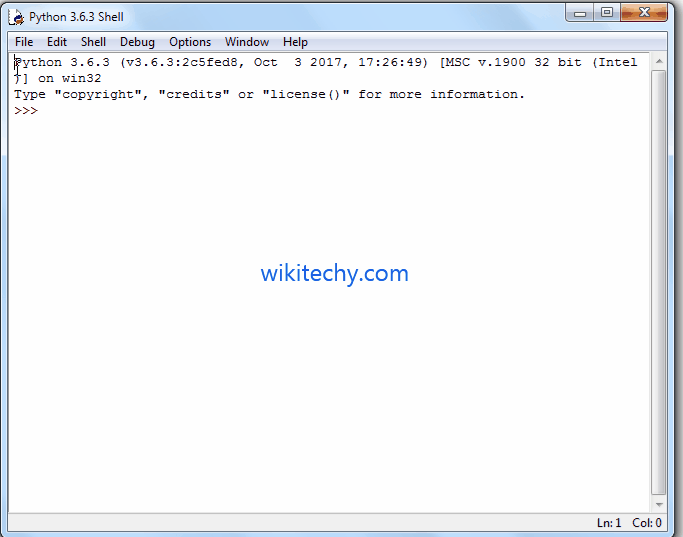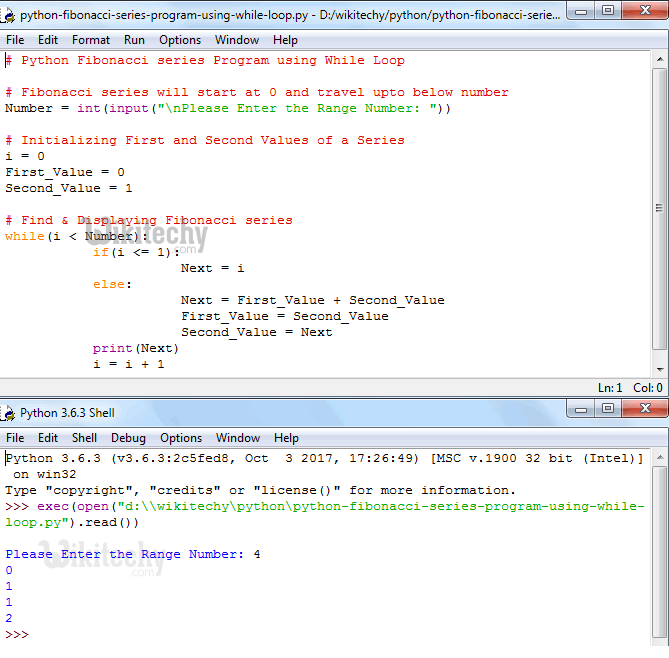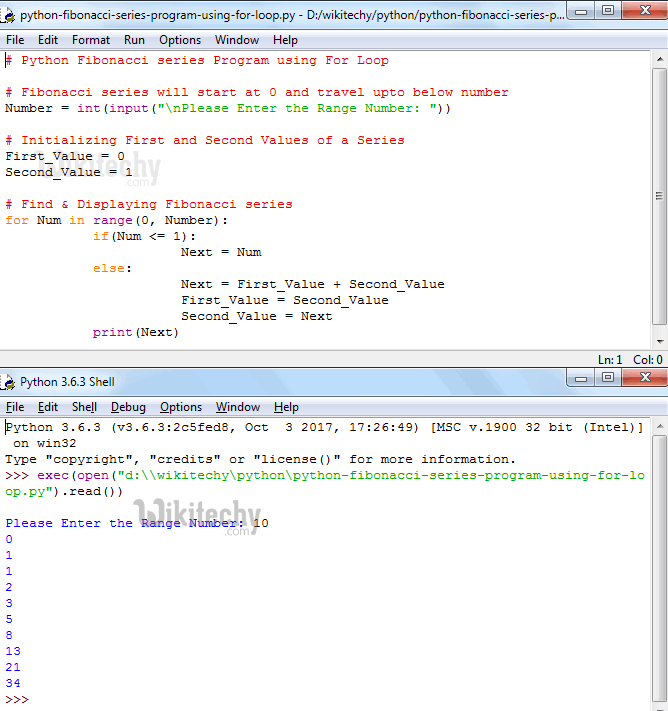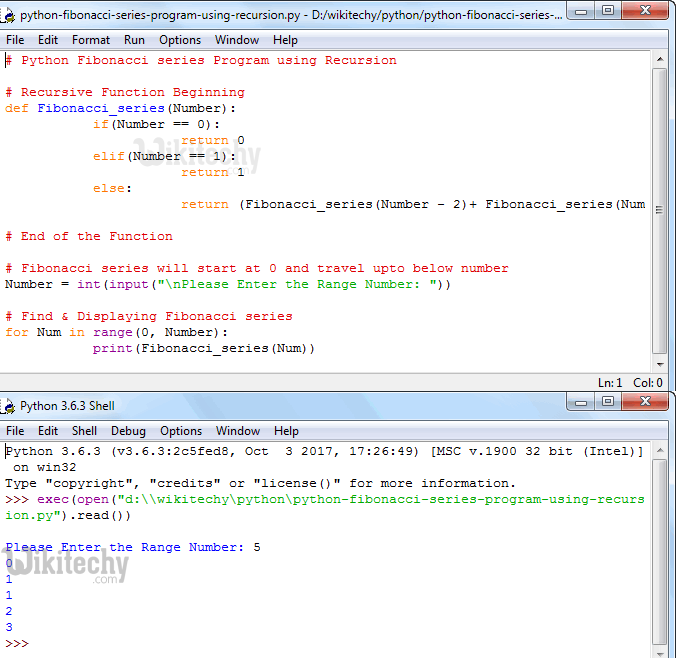python tutorial - Python Fibonacci Series program - learn python - python programming
Fibonacci Series
- In Mathematics, Fibonacci Series or Fibonacci Numbers are the numbers that are displayed in following sequence.
- Fibonacci Series = 0, 1, 1, 2, 3, 5, 8, 13, 21, 34 …
- If you observe the above pattern, First Value is 0, Second Value is 1 and the subsequent number is the result of sum of the previous two numbers. For example, Third value is (0 + 1), Fourth value is (1 + 1) so on and so forth.
- In this article we will show you, How to Write Python Fibonacci Series program using While Loop, For Loop and Recursion.

Learn Python - Python tutorial - Python Fibonacci Series program - Python examples - Python programs
Python Fibonacci Series program Using While Loop
- This Python program allows the user to enter any positive integer and then, this program will display the fibonacci series of number from 0 to user specified number using the Python While Loop
Sample Code
# Python Fibonacci series Program using While Loop
# Fibonacci series will start at 0 and travel upto below number
Number = int(input("\nPlease Enter the Range Number: "))
# Initializing First and Second Values of a Series
i = 0
First_Value = 0
Second_Value = 1
# Find & Displaying Fibonacci series
while(i < Number):
if(i <= 1):
Next = i
else:
Next = First_Value + Second_Value
First_Value = Second_Value
Second_Value = Next
print(Next)
i = i + 1click below button to copy the code. By Python tutorial team
OUTPUT

Learn Python - Python tutorial - Python Fibonacci Series program Using While Loop - Python examples - Python programs
ANALYSIS
- This program allows the user to enter any positive integer and then, that number is assigned to variable Number. Next, We declared three integer variables i, First_Value and Second_Value and assigned values as we shown above. Below While loop will make sure that, the loop will start from 0 and it is less than the user given number. Within the While loop, we used If statement.
- If i value is less than or equal to 1 then, Next will be i
- If i value is greater than 1, perform calculations inside the Else block.
while(i < Number):
if(i <= 1):
Next = i
else:
Next = First_Value + Second_Value
First_Value = Second_Value
Second_Value = Next
print(Next)
i = i + 1click below button to copy the code. By Python tutorial team
- Let us see the working principle of this while loop in iteration wise.
- User Entered value: Number = 4 and i = 0, First_Value = 0, Second_Value = 1
First Iteration
- While (0 < 4) is TRUE so, program will start executing statements inside the while loop
- Within the while loop we have If statement and the condition if (0 <= 1) is TRUE so Next = 0 and compiler will exit from if statement block
- Print statement print(Next) will print the value 0
- Lastly, i will be incremented to 1
Second Iteration
- While (1 < 4) is TRUE so, program will start executing statements inside the while loop
- Within the while loop we have If statement and the condition if (1 <= 1) is TRUE so Next = 1 and compiler will exit from if statement block
- Print statement print(Next) will print the value 1
- Lastly, i will be incremented to 1
Third Iteration
- While (2 < 4) is TRUE so, program will start executing statements inside the while loop. Within the while loop we have If statement and the condition if (2 <= 1) is FALSE so statements inside the else block will start executing
- Next = First_Value + Second_Value
- Next = 0 + 1 = 1
- First_Value = Second_Value = 1
- Second_Value = Next = 1
- Next, Print statement print(Next) will print the value 1. Lastly, i will be incremented to 1
Fourth Iteration
- While (3 < 4) is TRUE so, program will start executing statements inside the while loop. Within the while loop we have If statement and the condition if (3 <= 1) is FALSE so statements inside the else block will start executing
- Next = First_Value + Second_Value
- Next = 1 + 1 = 2
- First_Value = Second_Value = 1
- Second_Value = Next = 2
- Next, Print statement print(Next) will print the value 2. Lastly, i will be incremented to 1
Fifth Iteration
- While (4 < 4) is FALSE so, program will exit from the while loop.
- From the above, Our final output of Next values are: 0 1 1 2
Python Fibonacci Series program Using For Loop
- This Python program allows the user to enter any positive integer and then, this program will display the fibonacci series of number from 0 to user specified number using Python For Loop
Sample Code
# Python Fibonacci series Program using For Loop
# Fibonacci series will start at 0 and travel upto below number
Number = int(input("\nPlease Enter the Range Number: "))
# Initializing First and Second Values of a Series
First_Value = 0
Second_Value = 1
# Find & Displaying Fibonacci series
for Num in range(0, Number):
if(Num <= 1):
Next = Num
else:
Next = First_Value + Second_Value
First_Value = Second_Value
Second_Value = Next
print(Next)click below button to copy the code. By Python tutorial team
OUTPUT

Learn Python - Python tutorial - Python Fibonacci Series program Using For Loop - Python examples - Python programs
- We just replaced the While loop in the above example with the For loop. If you don’t understand the for loop then please refer For Loop article here: Python For Loop
Python Fibonacci Series program Using Recursion
- This Python program allows the user to enter any positive integer and then, this program will display the fibonacci series of number from 0 to user specified number using Recursion concept.
Sample Code
# Python Fibonacci series Program using Recursion
# Recursive Function Beginning
def Fibonacci_series(Number):
if(Number == 0):
return 0
elif(Number == 1):
return 1
else:
return (Fibonacci_series(Number - 2)+ Fibonacci_series(Number - 1))
# End of the Function
# Fibonacci series will start at 0 and travel upto below number
Number = int(input("\nPlease Enter the Range Number: "))
# Find & Displaying Fibonacci series
for Num in range(0, Number):
print(Fibonacci_series(Num))click below button to copy the code. By Python tutorial team
OUTPUT

Learn Python - Python tutorial - Python Fibonacci Series program Using Recursion - Python examples - Python programs
ANALYSIS
- In this example we defined a function. Following function will accept integer values as parameter value and return value
def Fibonacci_series(Number):click below button to copy the code. By Python tutorial team
- if (Number == 0) will check whether the given number is 0 or not. If it is TRUE, function will return the value Zero.
- if (Number == 1) will check whether the given number is 1 or not. If it is TRUE, function will return the value One.
- If the number is greater than 1 then the statements inside the else block will be executed.
- Within the Else block we called the function recursively to display the Fibonacci series.
return (Fibonacci_series(Number - 2)+ Fibonacci_series(Number - 1))click below button to copy the code. By Python tutorial team
For example, Number = 2
(Fibonacci_series(Number – 2)+ Fibonacci_series(Number – 1))
(Fibonacci_series(2 – 2)+ Fibonacci_series(2 – 1)), It means
(Fibonacci_series(0)+ Fibonacci_series(1))
return (0 + 1) = return 1
- NOTE: For Recursive functions it is very important to place a condition before using the function recursively otherwise, we will end up in infinite execution (Same like infinite Loop).
